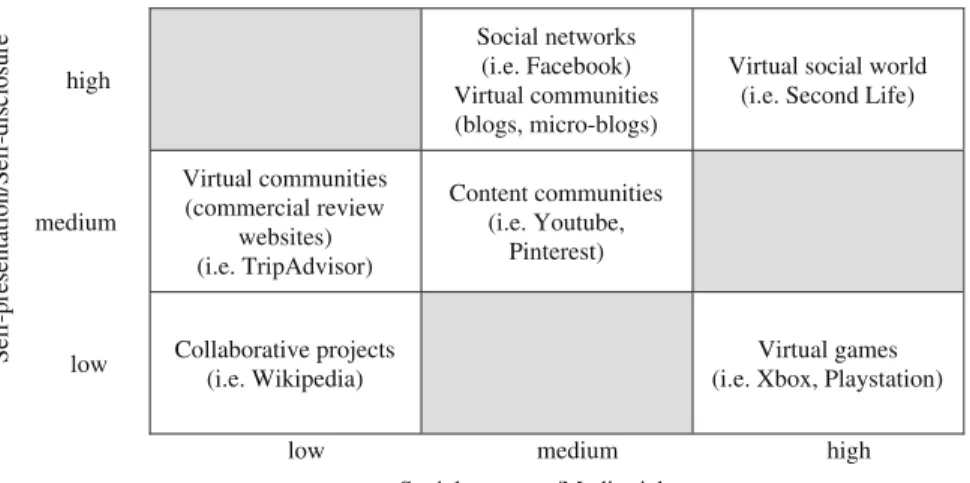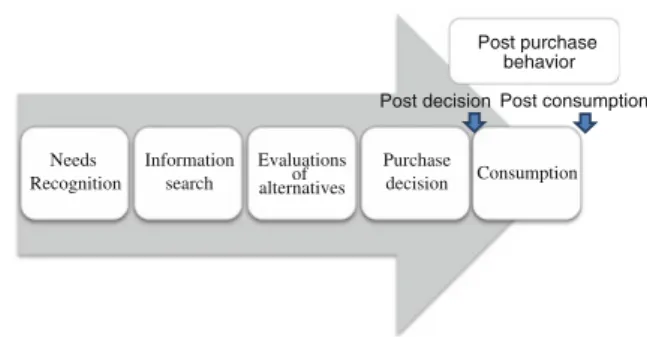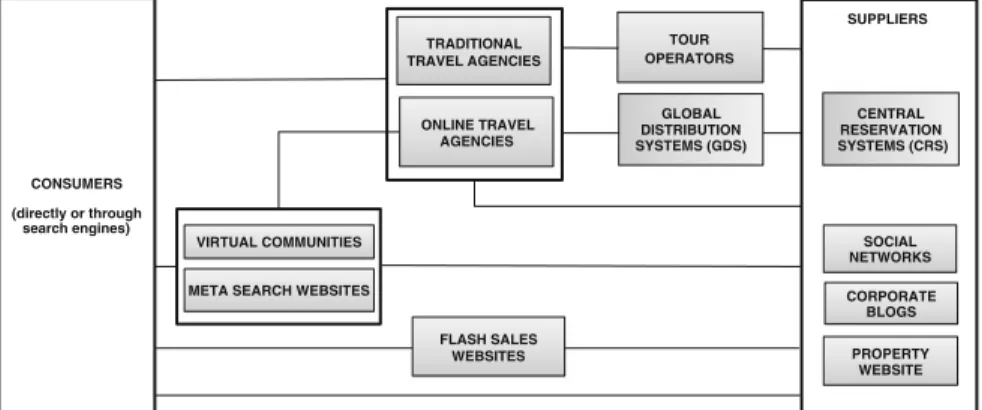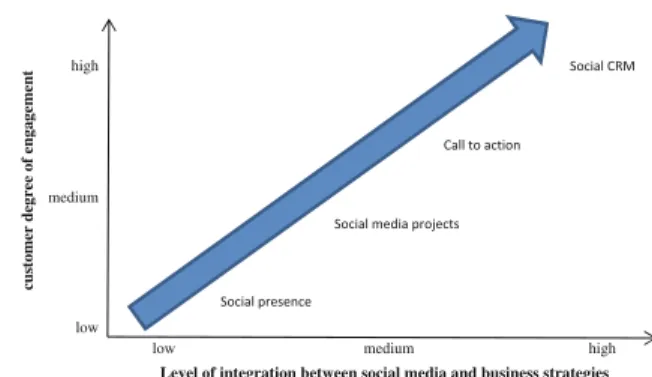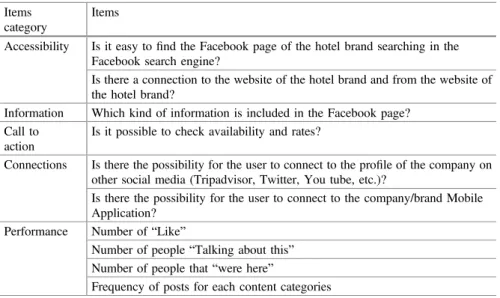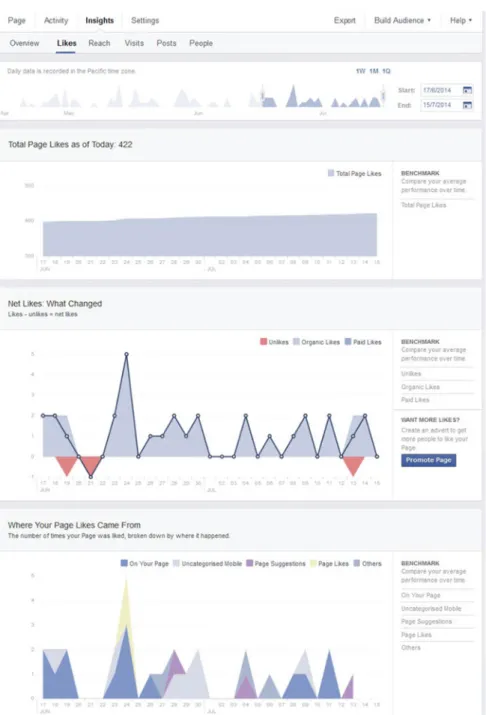The author offers an in-depth study of the impacts of social media on the tourism demand and supply sides. The first part provides an overview of the latest developments in social media and user-generated content.
ICTs Developments in Tourism
From Web 1.0 to Web 3.0: Concepts and Definitions
Social Media Classification
Collaborative Projects
Over the years, the quality of information (accuracy, completeness, comprehensibility) of Wikipedia has raised serious concerns (Fallis 2008). However, other studies that take the opposite view show that Wikipedia is a less reliable source of information than other reference resources (Gorman 2007; Rector 2008).
Virtual Communities
Based on the classification of social media described in the previous section (Kaplan and Haenlein 2010), microblogs have relatively high levels of social presence and media richness compared to traditional blogs (Kaplan and Haenlein 2011). On the contrary, the communication flow starts with the user describing his experience and evaluating each service according to the rules of the particular website.
Content Communities
Based on the assumption that the company's customers present similar characteristics to those of Pinterest users, boards can be created to address different target markets of interest to the company. The business account offers a dedicated area, Analytics, which tracks user pinning activity on the website (pins, repins, impressions and clicks) and allows the company to examine the data by date and type of content.
Social Network Sites
In fact, the Facebook business page cannot send or receive friend requests or view the profile of the page users. View and Apps” the portion of the page that the business can customize (it generally consists of the Photos and Events sections, but other features can be added);
Virtual Games/Social Worlds
The data also provides demographic information about site users, trying to understand how they respond to posts. This is true of the game Grand Theft Auto (GTA), especially in its latest edition.
The Development of Social Media in Tourism
Accessed September 2013 Mangold WG, Faulds DJ (2009) Social media: the new hybrid element of the promotion mix. The buying behavior of customers has changed more and more with the development of Information and Communication Technologies and social media.
The Concept of Word-of-Mouth
Summary From the first article published on the subject of electronic word-of-mouth (eWOM), research has increased rapidly, underscoring the importance of this phenomenon in various business contexts. Therefore, what has traditionally been defined as word-of-mouth (WOM) needs to be reconsidered and studied in the light of recent trends.
Word-of-Mouth and Electronic Word-of-Mouth
On the contrary, other consumers may read these reviews even after a long period of time (Buttle 1998; Hennig-Thurau et al. 2004; Breazeale 2009), while searching online for information about a specific product or service (Ward and Ostrom 2002). Therefore, customers activate "weak ties" with others to obtain information about specific features of the product (Brown and Reingen 1987; . Gruen et al. 2006).
Electronic Word-of-Mouth Outcomes
Chang et al. 2005) found that attitude significantly influences online purchase intentions and decisions. According to Gruen et al. 2006), online customer-to-customer exchange activities have a significant effect on the overall value of the firm's offerings and, consequently, on loyalty intentions.
According to Hu et al. 2012), authentic reviews differ from manipulated reviews because they are random and provide a personalized view of the experience that stems from the reviewer's specific background (i.e., culture, education, occupation, etc.). An interesting case is the contribution of Mayzlin et al. 2012) based on the comparison of the distribution and rating of hotel reviews between two different websites (TripAdvisor and Expedia) using the mentioned difference in organizational structure that a different distribution of online reviews should determine.
Dimensions for An Analysis of eWOM
The Message
Informational influence depends on the content of the message (central routing factors), while normative influence concerns the impact of online social aggregation mechanisms (peripheral routing factors) (Petty and Cacioppo1984; Cheung et al.2009). Recommendation consistency refers to the congruence of the message with the opinions of others about the product (the consensus of other reviewers on the subject).
The Communicator
It refers to the reputation of the website where the review is published (Brown et al.2007) and of the reviewer. According to various studies, the presence of details and personally identifiable information (PII) of reviewers (Xie et al.2011) is generally an indicator of message validity (Ayeh et al.2013).
The Receiver
In the latter case, it is sometimes assigned by the site administrator, and at other times it is marked by a specific and formal ranking based on the usefulness of the message (Hennig-Thurau et al. 2004; Zhang and Watts 2008). . In fact, the content of a message is evaluated in a different way according to the degree to which the receiver perceives similarity with the sender of the message, generally according to age, gender, education, social status, etc.
Recommendation Framing
Furthermore, dissatisfied customers are more likely to share negative experiences with other people (Richins 1983; Morris 1988; Hart and Heskett 1990; Tax et al. 1998). WOM valence can also influence customer expectations (Grönroos 1982; Zeithaml et al.1993).16 During the information research phase, customers gather information about the service from various known (WOM) and generally unknown (eWOM) sources, with a positive or negative valence (Mauri2002 ), and try to determine what you can expect from a specific service (Mauri and Minazzi2013).
Credibility of User-Generated Content
Reviews, Rankings, and Ratings in the Tourism
Cheung CM, Thadani DR (2012) The impact of electronic word-of-mouth communication: a literature analysis and integrative model. Park DH, Kim S (2008) The effects of consumer knowledge on message processing of electronic word-of-mouth via online consumer reviews.
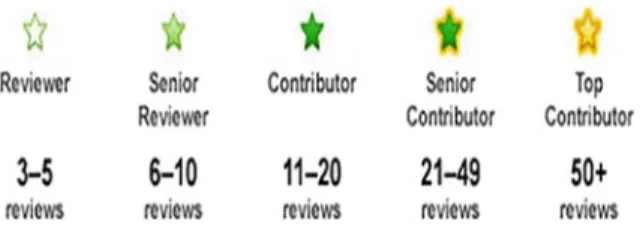
Consumer Behavior in Tourism
The influence of social media is analyzed for each stage of the travel planning process: before departure (before the trip), during the stay (during the trip) and after returning home (after the trip). Online information may be generated by customers (actual customers and prospects) who post content on their social media profiles, on other people's. Table 3.2 Online sources of information in the travel planning process.

The Travel Experience
The following paragraphs will explore in more depth the concept of the travel experience and the impact of social media on the steps of the traveler's planning process: the pre-trip, during-trip, and post-trip stages. In particular, smartphones offer various types of services that can enrich the tourist experience at all steps of the travel planning process.
Social Media Influence on Travelers ’ Planning Process
Pre-Trip Phase
In general, customers in the pre-trip phase search for information about accommodation and transportation (comScore 2013), but increasingly the Internet environment has become a place where people also search for other experiential travel products (attractions, shopping and restaurants). at the destination) (Fotis et al. In fact, plans developed in the pre-travel phase may change during the travel experience (Stewart and Vogt 1999; Jun et al. 2007).
During-Trip Phase
However, this means a real-time management of social media by employees responsible for this task. This means a gradual shift of some travel decisions from the pre-trip and post-trip phases to the during-trip phases.
Post-Trip Phase
The cited study of Fotis et al. 2012) for Internet users from Russia and the Republics of the former Soviet Union shows that 78% of them share content on social media in the post-travel phase. Similarly, Murphy et al. 2010) found that most young travelers interviewed usually share travel UGC on social media (Facebook) in the post-travel stage.
Sharing Travel Experiences on Social Media
Tourism Experience and Storytelling
Moreover, as mentioned in the previous chapter, the presence of first-hand experience is seen as an indication of the validity and credibility of the message (Schindler and Bickart 2005; Doh et al. 2009). Finally, we see the development of so-called Transmedia storytelling22, which relates to telling stories across multiple media platforms (Jenkins et al. 2006).
The Dimensions of Co-Creation Through
The narrative structure develops through various languages (verbal, iconic, etc.) and media (TV, smartphones, internet, video games, etc.) (Scolari 2009), which change accordingly. An example of this last case could be a video call during a concert that allows people at home to see part of the show, while experiencing in real time the same emotions of the friend who is physically present.
Motivations for Sharing Travel Experience
In this case, the customers who post a comment wish to have an informal or formal approval of the usefulness of their comments. Informal approval is derived from private or public online conversations while formal approval is given by a ranking system that assigns a score or status to each reviewer (ie, key contributor or expert) according to the usefulness of the comments.
Social Media Users
Lurkers and Posters
Research shows that it is difficult to find a common definition of lurkers in relation to the frequency of activity in society. On the one hand, companies could try to increase the frequency of participants' activities in the community (e.g. publishing engaging posts that generate interest).
Social Shoppers
The PwC (2013) study identified three behaviors of social media users: brand enthusiasts, deal hunters and social addicts. These types of social media users are interested in new products from the brand (28%) because they want to try them (17%), but they are obviously also interested in interacting with the brand (9%) and with other followers (7.
Social Media Users Demographics
Searchers have already considered a certain purchase and are looking for it through social networks. Summary In light of the impact of social media on traveler behavior previously analyzed in Chapter 3, this section highlights the effects on travel providers.
Recent Developments in the Travel Distribution System
The Role of Social Media in Travel Distribution
These operators could take advantage of social media and improve their ability for value creation and personalization. Moreover, these actions can also be useful to compete with new online intermediaries and to avoid being overtaken by travel suppliers who are increasingly aware of the possibilities of social media.
A Focus on Flash Sales and Social Couponing
Therefore, companies selling through daily offer websites can differentiate their strategies according to the macro area (North America, Germany, France, Italy, etc.) and based on the location indicated by the subscriber (micro area). If daily deals websites are generalist providers that also sell travel, then private sales offers some examples of specialized travel providers.
Social Media Approaches for Travel Companies
A Focus on Customer Engagement
According to van Doorn et al. 2012), customer engagement is the customers' behavioral manifestation (both positive and negative) towards a brand, product or company (beyond purchase) resulting from motivational drives. Therefore, customer engagement affects the duration of customer participation, increases satisfaction and brand loyalty (So et al. 2012), which in turn increases positive eWOM in the community and then further increases community engagement.
Social Media Approaches
This approach views social media as distribution and communication channels that support and integrate the marketing strategy. Many organizations view social media as a one-way flow of marketing messages, instead of a way to create conversations with consumers and prospects.
New Ways of Interacting with Customers
- Relationship Marketing
- Online Relationship Marketing
- Customer Relationship Management
- Electronic Customer Relationship Management
- Social Media Customer Care
The advancement of IT and social media offers companies the opportunity to develop dynamic relationships and interactions with customers from the very early stages of product development. One way businesses can use to manage customer relationships online is "Social Media Customer Care" (SMCC).
Travelers ’ Engagement by Means of Social Media
Consumers ’ Engagement in Online Corporate
In terms of funding and management, corporate communities can be created and then managed by the company itself and/or the community of enthusiasts of that brand/topic (Wirtz et al.2013). This is because governance can affect credibility: when the community is completely controlled and managed by the company, online content can be perceived as less credible.
Well Begun Is Half Done: Give a Good Welcome
A message that introduces the community and asks for a brief personal introduction can prompt new members to interact for the first time. Finally, beginners do not know all the community procedures and customs, so it can be useful to give them main information about the group and main working procedures in the first introductory message.
Engaging Content on Social Media
The perception of appropriate response time obviously varies according to the type of social media considered. Links Is it possible for the user to link to the company's profile on other social media (Tripadvisor, Twitter, You tube, etc.).
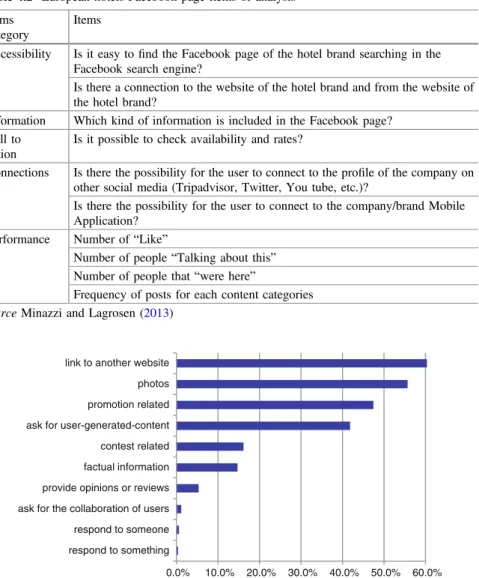
How to Manage Electronic Word-of-Mouth
A Focus on Online Travel Reviews: Reply
A stream of research considers online reviews as an opportunity rather than a threat for travel providers (Litvin et al.2008) and a new marketing tool (Dellarocas2003) that allows posting product information, chatting and engaging with customers to communicate. Specific rather than generic management responses are perceived more favorably by travelers and can increase trust (Wei et al. 2013).
Social Media and Communication
A Focus on Facebook Advertising Tools
However, we may consider "free advertising" the company's action to publish a post containing promotional content (offers, events, etc.) directed at people who "like" the company's page. On the contrary, paid advertising can reach a larger audience of customers and prospects that go beyond the boundaries of the company's network.
Social Media Use Within Pricing
In addition, customers are involved in the benchmarking process using social media metrics such as rankings, ratings, likes, etc., which become indicators of quality and have the power to increase web reputation. Bruni L, Francalanci C, Giacomazzi P (2012) The role of multimedia content in determining the virality of information on social media.
Mobile Technology Influence on Travelers
A study by Wang et al. 2012) on user evaluations of smartphone applications reveals that smartphone use mediates the tourism experience by changing behavior and emotional states. People become “mobile storytellers” (Klastrup 2007): they can create context-related information (Buhalis and Foerste 2013) and share experiences in real time (Qualman 2012; Litvin et al. 2008) using mobile devices.1.
From Virtual Reality to Augmented Reality
In practice, Mobile Augmented Reality (MAR) allows travelers (owners of a smartphone) to point the device at a physical object in the environment and visualize different types of content and information according to the application (video, images, text). Another example of Mobile Augmented Reality (MAR) is the possibility offered by smartphones to point a mobile device towards a physical object in the environment and to visualize different content also without a QR code.
Social Media and Mobile Media: Mobile Social Media
Quick timers refer to traditional social media apps that “go mobile,” but in this case to enhance immediacy. Therefore, we find that the types and scopes of mobile social media applications are changing rapidly.
Mobile Social Media Marketing in Tourism
Regardless of the decision to develop a mobile app or not, travel suppliers can leverage specific features of mobile social media to improve market research, communication activities, sales promotions, and relationships (Kaplan2012). Therefore, a key issue turns out to be the determination of the most appropriate social media metrics able to evaluate social media performance and, if combined with other measures, support and improve business strategies.
Learning from Customers: “ Big Data ” and Customer
The Evolution of Analytics: “ Big Data ”
Big data” is a relatively new term used to define the explosion of the amount of digital data currently available. Analytics and reports, as traditionally intended, are only one part of analyzing big data.
Big Data Analytics
Big data measurement enables companies to extract value from data to improve service delivery and internal operations. Real-time processing of big data allows companies to provide more detailed and personalized information to consumers.
It is Not Only About Technology, It is About
The analysis of unstructured data from social media and online conversations can help travel organizations determine 'sentiment' towards a product, service, destination, company, etc. Businesses need to seize the opportunity offered by social media to collect and analyze unstructured user information to develop the right metrics.
Social Media Metrics
- Foundational Metrics
- Business Value Metrics
- Outcome Metrics
- Counting Metrics
The impact of social media activities can be measured by evaluating the expected result against a specific objective. This metric can be calculated for a group of social media or for each medium, in the latter case it allows comparison.
Sentiment Analysis
Rather, automatic sentiment analysis uses complex algorithms that process strings of text and determine the overall sentiment (either positive, negative, or neutral). 13 For a review of the literature on the concepts of opinion mining and sentiment analysis see Pang and Lee (2008).
A Focus on Facebook Insights
Post Reach shows the number of people who actually saw the company's post (both organic and paid); 17. Total reach shows the number of people who have seen any activity on the page (posts, check-ins, comments, etc.).
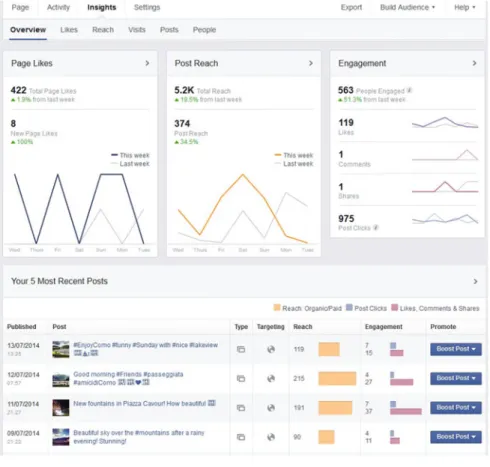
Privacy Implications
Therefore, more effective techniques are needed to protect social media (and the Internet in general) users from potential alleged violations. In addition, they can also have the opportunity to also reach skeptical users of the internet and social media that inspires confidence.
